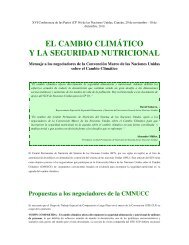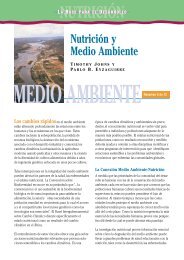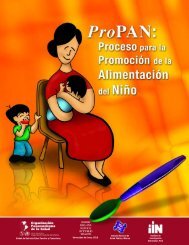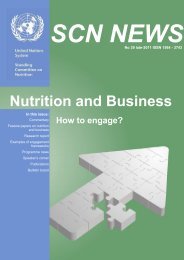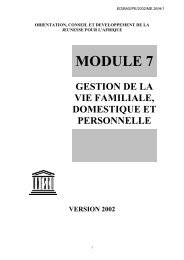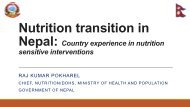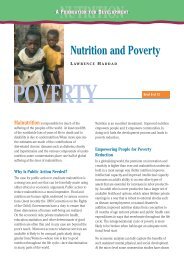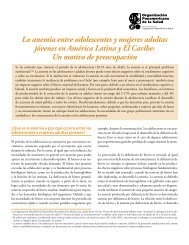SCN News No 36 - UNSCN
SCN News No 36 - UNSCN
SCN News No 36 - UNSCN
You also want an ePaper? Increase the reach of your titles
YUMPU automatically turns print PDFs into web optimized ePapers that Google loves.
www.unsystem.org/scn FEATURES 41<br />
“They (NGOs) are at odds with one another in many respects, and that makes the situation a little more<br />
confusing. That’s true for [all three countries].” (International NGO)<br />
Structural factors<br />
As suggested above, many of the disagreements concerning nutrition strategies and interventions are<br />
intimately related to divergence in institutional perspectives, interests and agendas. Other structural factors<br />
can also create challenges for the relevant actors. One such factor relates to short funding periods for<br />
externally-financed projects, interventions favoured by donors and other donor procedures and practices.<br />
“So at the time, the pervasive impression from the nutrition community was that that shift occurred because there was<br />
a lot of advocacy and a lot of pressure from donor agents, who wanted their micronutrient programs implemented in<br />
the (country).” (University professor in developing country)<br />
“<strong>No</strong>t being committed to intervention undermines the process. What we saw was efficient small scale programs<br />
financed by (donors), but these did not manage to make the jump to larger scale program. Whenever financing ends<br />
[], they just leave program to dead” (Donor agency)<br />
One of the most common problematic structural factors relates to institutional arrangements for promoting<br />
and coordinating a multisectoral approach to nutrition.<br />
“Multisectoral committee? It is fragmented. It was in the strategy that MoH should have the implementation role, and<br />
be coordinated by the Prime Minister. However, the Prime Minister does not have a coordinating power or mandate<br />
to coordinate the ministries” (Country nutrition actor)<br />
“[Country] established a National Food and Nutrition Committee in 1996, chaired by the Ministry of Agriculture. []<br />
However, without any budgetary authority, this committee remained largely ineffective in shaping nutrition policy and<br />
action.” (Country nutrition actor)<br />
Finally, poorly implemented de-centralization was a common structural sub-theme in many countries:<br />
“Decentralization, although it’s a great idea, really was more a failure than anything else because there was a<br />
total lack of capacity at the regional level to absorb those resources and (to) absorb the new<br />
mandates.” (International NGO)<br />
“Most of the de-centralization process is completely stuck on taxes that local government gets, and (on) the<br />
ministries refusing to give up their control over their system. ” (Donor agency)<br />
Strategies and tactics<br />
One of the most insightful and valuable themes to emerge from this study of country experiences relates to<br />
the wide variety of strategies and tactics used by nutrition actors to address, overcome or circumvent the<br />
many obstacles and complications described in the first four themes. These are clustered in three<br />
overlapping categories (Table 1). Molding and adapting to institutions refers primarily to strategies used to<br />
deal with the Structural Factors described above. Planning and agenda formation refers to strategies used<br />
specifically to seek agreement on a common agenda, and Leadership and Strategic Capacity refers to<br />
personal, interpersonal and tactical considerations involved in forming and advancing the agenda. Though<br />
the boundaries among these sub-themes are quite fuzzy, they begin to reveal a body of craft knowledge with<br />
considerable practical utility.<br />
The following quotes illustrate some strategies used to form agreement on a common agenda despite the<br />
existence of structural barriers, diverging institutional interests and points of contention:<br />
“NGOs got together and sort of formed a networking organization or an alliance. They agreed to put their logo on all<br />
the national program reports rather than trying to claim ownership for themselves, and things like that. So there was a<br />
period where there was a lot of, fairly large NGO-run programs, and they wanted to make it one national program,<br />
and they managed to get their act together to do that.” (International NGO)<br />
“[] they had a lot of disagreements but they always went ahead with one voice. They sat behind closed<br />
doors and didn’t get out, but then they put on a good face when they came out and had one<br />
recommendation. (Donor agency)<br />
“The 10-year plan and 5-year program became the references for external assistance to the health sector. The World<br />
Bank agreed to a US$40 million credit to assist the implementation of (the program).” (Country nutrition actor)<br />
These quotes reveal some strategies that have proven useful in aligning the diverse actors, building<br />
ownership and ensuring sustainability of commitment over time:<br />
back to contents <strong>SCN</strong> NEWS # <strong>36</strong>





